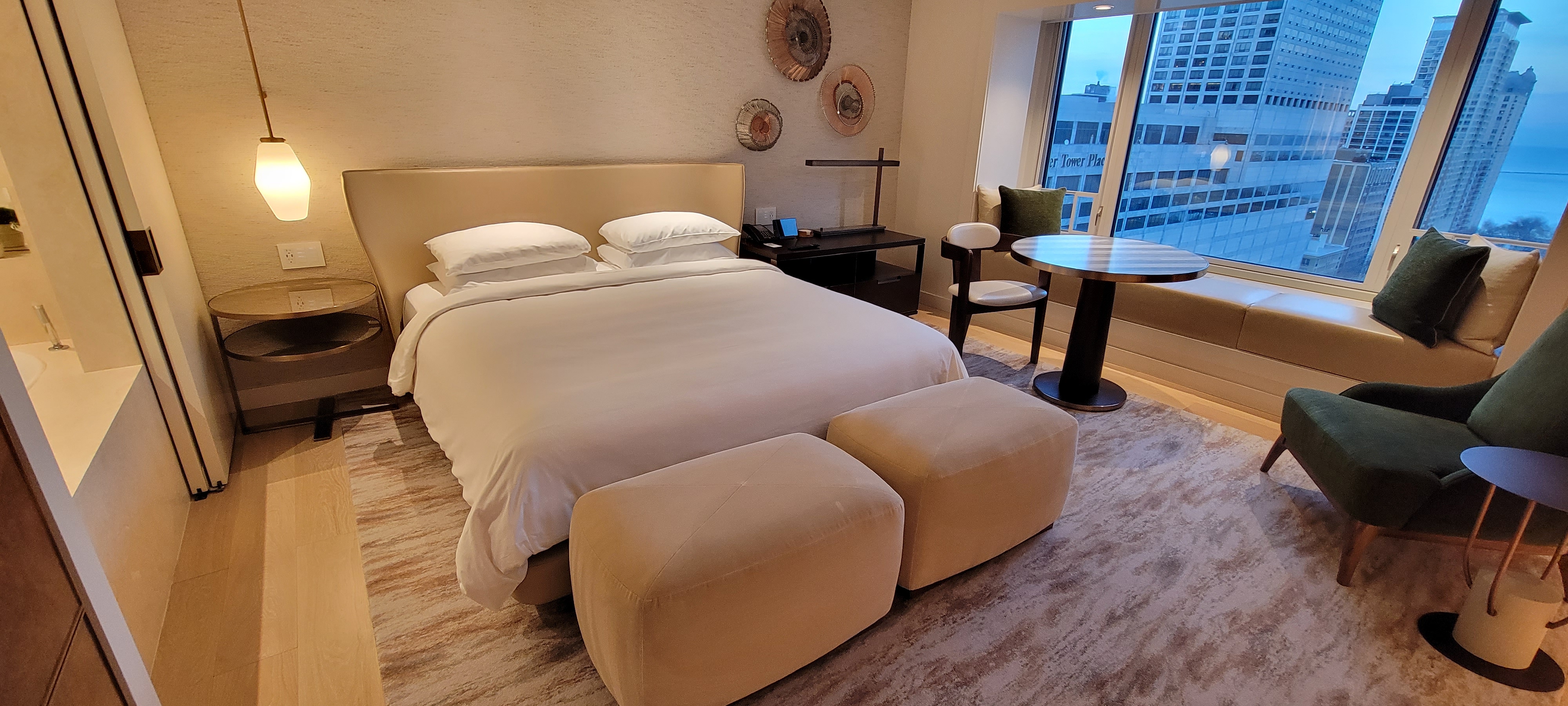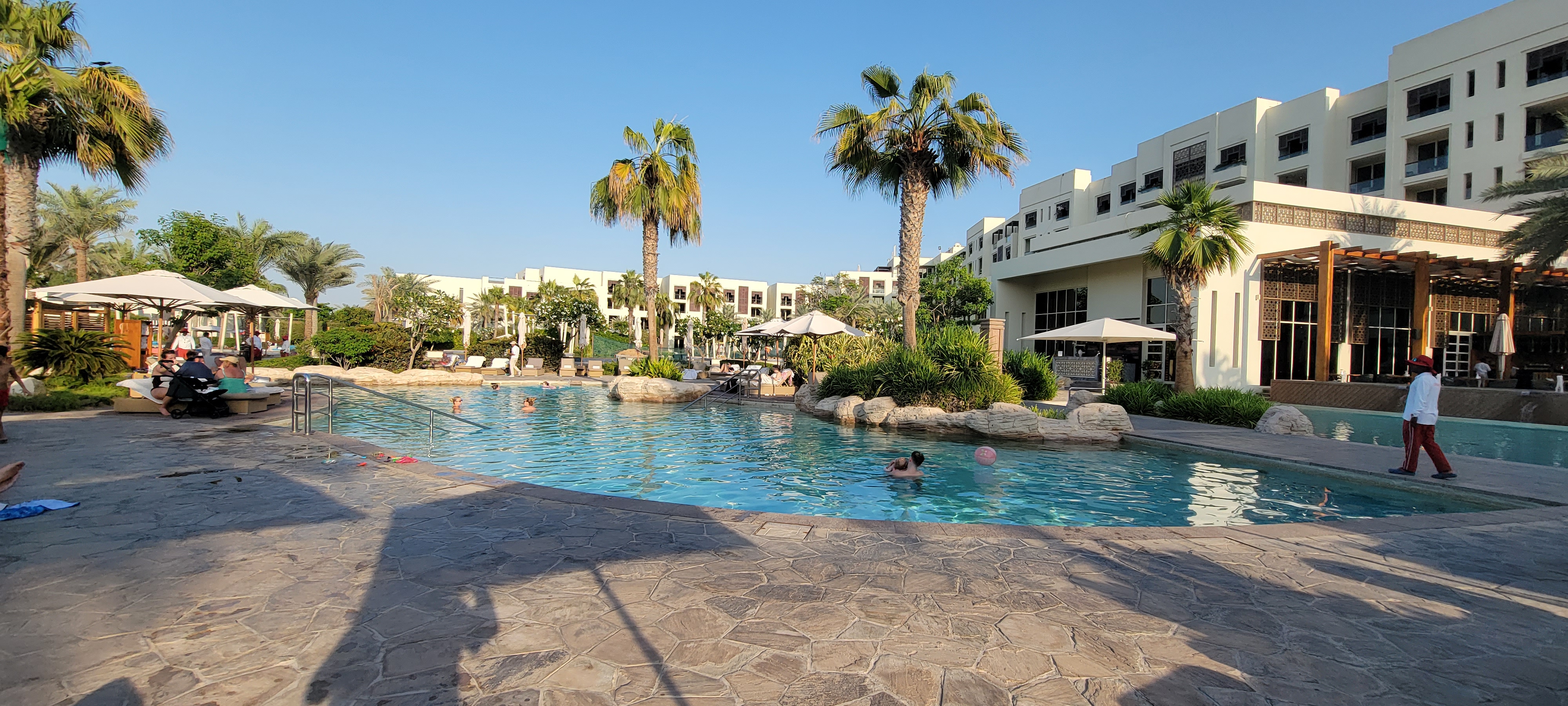Hyatt missed on earnings and its stock dropped around 7%, to its lowest level in about six weeks, but they’re fine and I’m less interested in hotel chain earnings than airline earnings (the financials of their loyalty programs and the tax implications of those are another matter).
Sean O’Neill at Skift does a good job summarizing the strategic questions from their earnings call.
- Since they’re small they have more room for growth than the largest chains. Hyatt CEO Mark Hoplamazian said, correctly,
We’re not running into ourselves in any market in the world, so we have a lot of space to grow [which would be] very welcome by our loyalty members.

Park Hyatt Chicago - They’re generally focused on premium demand. That lack of diversification could leave them vulnerable in a downturn, but also means they generate more value per customer – their loyalty members “have relatively higher net worth and household income” – and they have a clearer value proposition to the customer.
Hoplamazian says his ‘eyes are wide open’ but also seems to roll his eyes at the strategies of Marriott et al here, “When you approach Hyatt, you’re not going to have a cacophony or a laundry list of brands.”
Our eyes are wide open that our other competitors have very large collections of conversion brands, including some in the midscale or lower mid-scale arenas. But I don’t see us going there because it’s not a market that we currently play in.

Park Hyatt Abu DhabiHyatt Studios (“upper-midscale extended-stay brand”) is their lowest-end product. It’s unclear whether these will appeal to the chain’s current customer base.
- They’ve doubled the rate – up to 1.5% of rooms – at which they’re pushing properties out of the system when they aren’t upholding brand standards. Unlike Marriott they don’t have lower-end brands with more flexible standards to downgrade hotels to. He points to some of the legacy Amerisuites properties that were acquired and became the Hyatt Place brand 20 years ago, where owners didn’t keep up the hotels. Frequent travelers generally like new build Hyatt Places and dread the ex-Amerisuites ones.

Hyatt Place Lobby - Loyalty program membership is up 22% year-over-year, with a total of 51 million members. That’s not active members, and hotel program membership numbers are inflated because customers join at booking to save ~ 2% with ‘member rates’.
- The Hyatt credit card unquestionably hits above its weight relative to the size of the chain. Chase co-brand card spend rose 16% year-over-year during the first 9 months of 2024. They expect to renegotiate the deal on better terms by the end of 2025.
- They view the Grupo Pineiro Bahia Principe joint venture with 23 all-inclusive resorts as adding a “4.5 star” option on top of the mostly 5-star all-inclusives in their current portfolio.

Park Hyatt Maldives
In sum, Hyatt’s latest earnings call reveals a firm commitment to premium brands as CEO Mark Hoplamazian dismisses low-end market competition, emphasizes loyalty growth, and sets sights on renegotiating a lucrative credit card partnership.


“When you approach Hyatt, you’re not going to have a cacophony or a laundry list of brands.”
How is that true? HYATT HAS 25 BRANDS.
“We’re not running into ourselves in any market in the world, so we have a lot of space to grow [which would be] very welcome by our loyalty members.”
It’s hard to run into yourself when you are absent from entire states.
What bunch of bull re: brands.
Marriott brands: 35
Hilton brands: 24
Hyatt brands: 29 (and that’s before Standard and the latest all-inclusive addition)
Vast majority of Hyatt all-inclusives are 4 star at best and often terrible point redemptions
Hyatt has enough hodge podge brands that the only thing really not there in the Hyatt umbrella are low-end motels.
All inclusive brands are not high end.
Odd how he seems to view the brand. Yes Hyatt has some nice high end properties (so do Hilton, Marriott and IHG) but there is no way I would consider Hyatt Place and Hyatt House (the majority of their hotels) as “high end”. IMHO they are comparable to a Marriott Courtyard – a nice place to stay but nothing special and definitely not high end. Also some of the Hyatt Places were bought and converted. Many of these are horrible – stayed at the Hyatt Place Dallas Grapevine recently and it was a dive.
“Hyatt Studios (“upper-midscale extended-stay brand”) is their lowest-end product. It’s unclear whether these will appeal to the chain’s current customer base.”
I think it’s fairly low-risk depending how they structure the owner contracts. If they were smart, they’d have fairly loose restrictions on what can be done with the brand’s ownership. That way, if it doesn’t work out, they can spin it off to someone like Wyndham without much fuss. Biggest issue would be getting owners to agree to switch the loyalty programs that are earned.
@Dirk – I can’t disagree with you there, but all-inclusives have call themselves 5 star (even though most of are really more like 3.5-4.5*) because the resorts meet the 5* resort definition on paper (e.g. room service, multiple restaurants/bars, concierge/bellhop services, large pools, 40-60 sq meter base rooms with a sitting area, beachfront with a dedicated beach area, in-house spa, etc.) even if most feel more like a Hilton resort rather than Four Seasons.
If anything, I’m surprised some brands haven’t tried to redo the ratings because it hurts their resort differentiation. Iberostar, for example, has 4 tiers of resorts in their Riviera Maya complex that have vastly different levels of amenities and the most expensive resort’s base rooms are often 2x the price of the cheapest, yet they flag all of them as ‘5 star’.
@AC: I don’t even consider Hyatt Place to be equivalent to Courtyard. Hyatt Place to me is more like a Fairfield or Holiday Inn Express but with a bar. Certainly not upscale.
All inclusive properties doubled from 25k to 50k points in the last 2 years and they don’t even include two kids. Horrible value for points.
I suppose much of it is about developers, and the ‘asset light’ strategy that means the chains no longer own most of their hotels, but I’d love to understand why chains do not consolidate more brands.
For example: Hyatt already had its own all-inclusive brands, Ziva and Zilara. With all of the acquiring they have done in the all-inclusive space, why not brand more of these under that umbrella, instead of introducing more brands?
Similarly, it seems some hotels branded Alila (e.g., Encinitas, Napa Valley, etc.) could easily be branded as Park Hyatt. There’s also a lot of similarity between Andaz and Thompson. I get that a Hyatt Place isn’t a Hyatt Regency–there’s differentiation there–but the differentiation between a lot of the brands in the same tier just isn’t there. It’s marketing gobbledy-gook.
So many of the brands that have been launched have barely grown. For example, in the U.S. and Europe, the Andaz brand has barely grown. It seems you’d get more recognition for the brand by eliminating some and having more of a combined brand.
I’d also find it fascinating to learn what it actually takes to have a hotel kicked-out of the brand. I’m glad they’ve stepped-up efforts there, as there’s no faster way to ruin a brand than have a lot of hotels in it that are dives. For example: how the Hyatt Regency Lisle (IL) has passed *any* brand inspection is beyond me. Read the TA reviews. And it’s been that way for *years,* in the backyard of Hyatt’s headquarters in Chicago.
“I suppose much of it is about developers, and the ‘asset light’ strategy that means the chains no longer own most of their hotels, but I’d love to understand why chains do not consolidate more brands.”
@BRMM: Asset light — that is, not owning your own hotels — is not unusual or even a new strategy. It’s really a question of whether you manage [operate] your properties or franchise/license your properties.
IHG is almost 100% franchised/licensed; even top-end brands like Intercontinental.
While more than 70% of Marriott properties are franchised/licensed, the company has at least managed most full-service properties outside the USA and almost all top-end branded properties. But that’s no longer the case.
Until recently, Hyatt didn’t even have a corporate leader responsible for franchising. That’s because Hyatt managed the vast majority of all properties under all brands. That’s changed as Hyatt now almost exclusively franchises or licenses its limited-service properties. And, of course, Hyatt acquired a lot of new brands — timeshares, resorts, etc.
That aside, the reason why many chains don’t consolidate brands is because they believe owners don’t want to build the 12th Fairfield in a given market or the 5th Holiday Inn. They think every block of a big-city downtown needs different branded hotels, not a Fairfield on every block. Additionally, there are some legacy agreements with certain owners giving them geographic exclusivity. This was an issue in Southeast Asia, if I recall correctly, when Marriott acquired Starwood.
Of course, Starbucks is known have two Starbucks directly across from each other. And Marriott has two JW Marriotts in Miami itself.
How can you not see Hyatt Place and Hyatt House as high end brands
Have you tried their powdered eggs and canned fruit cocktail in syrup?
I stay at Hyatt a lot and am a Lifetime Globalist. I can’t stand that they are adding all these new brands (that already exist) to their portfolio. I want consistency in benefits. I especially always want complimentary full breakfast, not a croissant and coffee. I can’t get that benefit the way Hyatt has bought existing brands that compliment their portfolio so far as location but in no way the manner in which they provide benefits (TSU’s and full breakfast).
Non US members have no way of getting a WOH affiliated card. So the only way to earn points is through stays. C’mon, increase the elite bonus from a measley 30% to at least 50% and have some sort of elite welcome bonus too. Hyatt is the only brand that does not welcome its loyal members other than front office staff uttering a useless “We value you as a Gloablist member” stance at check in.
The reason they are not going there is because they are but there?
That’s some bizarre logic
@FNT Delta Diamond – maybe I was generous comparing Hyatt Place to Courtyard but I tend to group all the mid level chain brands (HI Express, Fairfield, Courtyard, etc as a group). I do realize there are differences and when you get to a Hilton Garden it is a little nicer. However, I was mainly referring to a grouping like (a) low end last resort motels (lot of Choice, Wyndham, etc properties), (b) mid level acceptable major hotel chain brands (ones I listed above), (3) full service higher end hotels (Marriott, Hilton, Hyatt Regency, etc) and (4) Luxury properties (Park Hyatt, Ritz, Waldorf, JW Marriott, etc). I know many will quibble with my breakdown (and could easily add a level between my 2 and 3 for Embassy Suites and similar such properties) but was just trying to point out most of the Hyatt hotels today are what I would consider basic mid level chain hotels instead of something special like the CEO seems to indicate.
@guyB: Pre-World of Hyatt, the old Hyatt program had these kind of perks. They eliminated the perks to lower costs but kept breakfast for globalists. The once-brand standard club lounges at Hyatt Regency are nonexistent, making the lounge benefit for globalists and the certificates for lower-tier elites useless.
ALWAYS LOVED HYATT!
HOWEVER, THEY LOST THE “HYATT TOUCH”